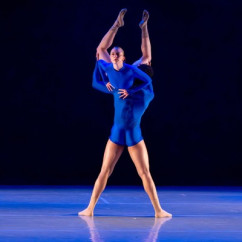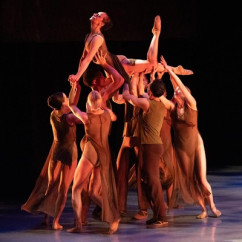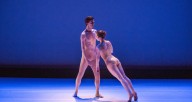Chicago Repertory Ballet's mixed repertory program, "Modern Motions," was an exhilarating evening of dance at the Ruth Page Center for the Arts, which showcased the company's versatility and technical prowess. The bill featured two world premiers, two company premiers and two pieces of CRB repertoire. Each dance was a unique expression of emotion, movement and narrative, seamlessly blending classical techniques with innovative contemporary styles.
An impressive feat of the evening was the diversity of the work. From the hauntingly beautiful "Trees, Melody" to the electrifying energy of "Spring Waters Pas de Deux," each piece offered something unique, keeping the audience engaged and enthralled throughout the evening. The dancers displayed remarkable versatility and embodied the essence of each piece with precision and grace, seamlessly transitioning between classical ballet, contemporary ballet and post-modern choreography.
 “Blue Roses Falling”, Chicago Repertory Ballet; Photo by Topher Alexander
“Blue Roses Falling”, Chicago Repertory Ballet; Photo by Topher Alexander
The opening piece, "Blue Roses Falling," choreographed by Brian Enos, set the stage for the evening, combining post-modern movement with the elegant simplicity of classical ballet. The condensed version of the original fifty-minute-long work highlighted the CRB ensemble’s ability to drift between dance genres. The dancers expressed the work’s fluid transitions as they performed much of the work in unison, each like a petal of a rose. The juxtaposition of sharp, angular movements with moments of softness created a sense of tension and release that paired with the musical score, which was created in tandem with Enos’ choreographic process. Hopefully, CRB will be able to exhibit the full-length work in the future, as it is a strong representation of the varied capabilities of the company dancers.
“Modern Motions” presents two world premiere works: “Lúa Descolorida,” by founding artistic director Wade Schaaf, and “Til Then I’m Yours,” by choreographic duo Braeden Barnes and Michelle Meltzer.
In “Lúa Descolorida,” every movement is a tribute to the celestial wonder that has captivated poets and dreamers for millennia and has certainly ensnared Schaaf’s wonder. The work is divided into two parts, the first a female corps on pointe under an eerie red moon, and the second, four sets of partners embracing the warmth of a gentle white moon.
Under the foreboding presence of the red moon, dancers huddle together, and limbs emerge like shadows through the empty spaces between bodies. Their movements were sharp and angular, reacting to and reflecting the unsettling presence of the daunting moon above. With each ominous musical chord, they leaped across the stage and threw their legs to the sky, their frenzied steps evoking a sense of impending doom. It is as if the night sky they are gathered under has been tainted by an ancient curse.
 “Trees, Melody”, Chicago Repertory Ballet; Photo by Topher Alexander
“Trees, Melody”, Chicago Repertory Ballet; Photo by Topher Alexander
In the ethereal glow of the white moonlight, the female dancers gracefully twirl and leap across the stage, their movements mirroring the celestial elegance of the moon, while their partners lift them to great heights and catch them out of daring jumps. With each step, they evoke the mystique and allure of Earth's celestial companion, as the music’s haunting melody composes a tale of cosmic romance.
“Til Then I’m Yours” is a whimsical contemporary ballet inspired by the enchantment and (after an extended period) the disillusionment of a music box dancer. Meltzer and Barnes seem to question what happens to this ideal object once the initial glamor has become timeworn. As the dancers weave and swirl across the stage, they transport the audience into a magical realm where time stands still. Dancers pirouette and twirl as if brought to life by a charming melody and evoke still images of classical ballet positions and gestures to bring to life the classic image of the mechanical dancer on pointe. Their fluid motions mirror the intricate mechanism of the music box spinning and revolving with effortless grace, and with each delicate gesture their expressions radiate joy and wonder.
The simple and timeless ideal of the music box dancer begins to dismantle as a sinister opera aria fills the theater and dancers move throughout the space with vigorous contemporary improvisation by throwing black roses in the air to fall onto the stage. The tradition of roses being tossed onto the stage after a performance serves as a poignant reminder of the connection forged between performers and the audience, each rose representing an individual's appreciation for the dancer's skill and artistry. The roses being black suggests that the overproduction of this ideal of the music box dancer—and thus the ballerina—can lead to an altered reaction from its audience.
Chicago Repertory Ballet's "Modern Motions" was a mesmerizing journey through the possibilities of contemporary ballet. With its captivating choreography, stellar performances, and evocative soundtrack, the production showcased the company's talent and artistry, leaving a lasting impression on all who had the privilege of witnessing it.
For more information on Chicago Repertory Ballet, click on the company link below.


